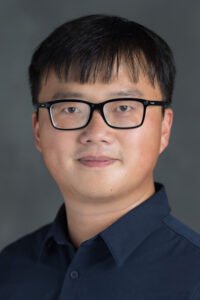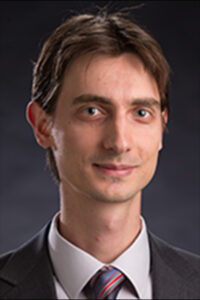This fall, Assistant Professor Sicheng He and Associate Professor Omer San joined the aerospace engineering faculty of UT’s Department of Mechanical, Aerospace and Biomedical Engineering (MABE).
Sicheng He received his PhD in aerospace engineering from the University of Michigan, Ann Arbor, and worked as a post-doctoral research associate at MIT before accepting the faculty position in MABE. He is a member of the American Institute of Aeronautics and Astronautics (AIAA) and the International Civil Aviation Organization (ICAO) and a reviewer for many journals, including the AIAA Journal, Structural and Multidisciplinary Optimization, and the International Journal for Numerical Methods in Fluids.
Sicheng He has spent the past couple of months settling into his new role and getting his lab, Dynamical System Multidisciplinary Design Optimization Laboratory (DMDO Lab), up and running. He describes his research as being at the intersection of multidisciplinary design optimization (MDO) and dynamical system theory.
“In recent decades, MDO has made significant progress in solving steady-state problems, like aircraft design optimization at cruising conditions,” said Sicheng He. “However, many emerging engineering problems, including laminar wing design for electric vertical take-off and landing (eVTOL) aircraft and flutter suppression for the large-scale offshore wind turbine, require optimizing designs over more complex solutions of dynamical systems. For example, when flow crosses the laminar-turbulent transition—such as when a steady column of candle smoke starts to billow after a few inches—that process involves bifurcation and chaotic systems. In my research, I try to bridge this gap by developing new algorithms and software. I want to make these challenging problems optimizable.”
Historically, finding a laminar-turbulent transition model is a challenging and time-consuming process, so Sicheng He is currently trying to develop machine learning (ML) algorithms and a platform that will expedite the development of such models with higher accuracy. The expected results may be used to design next-generation aircraft, reducing their fuel needs and carbon footprint.
Sicheng He is happy to be part of MABE and looks forward to growing his research program.
“My colleagues at MABE are very smart and supportive,” said Sicheng He. “Together, we are conceptualizing several collaborated projects that can extend the application and impact of MDO to other fields, including heat transfer and control theory. I am also very grateful for the funding support of the department and the reduced teaching and service load for the first two years, which gives me a great opportunity to learn the process of research project development.”
Sicheng He is actively recruiting students to work in his lab and invites any undergraduate or graduate students who are interested in his research to contact him.
San received his PhD in engineering mechanics from Virginia Tech and worked as an associate professor at Oklahoma State University (OSU) before joining MABE. He is a member of the American Physical Society, AIAA, and the Society for Industrial and Applied Mathematics, and is an academic editor for PLoS ONE specializing in oceanography, applied mathematics, artificial intelligence, and data science. He received an Early Career Faculty Award and Excellent Scholar Award from OSU and is a recipient of a DOE Advanced Scientific Computing Research Early Career Research Program Award.
He was drawn to the University of Tennessee for several reasons.
“I’m highly impressed by the expertise and excellence exhibited by my colleagues, the vibrant research culture, and the university’s strategic location,” said San. “I’m enthusiastic about collaborating with researchers at UT and Oak Ridge National Laboratory to advance scalable, trustworthy, and safe AI technologies. I’m excited about the state-wide and campus-wide initiatives in AI, data science, high-performance computing, energy, aerospace, autonomy, healthcare, and sustainability. I’m also open to forging partnerships with industry and education experts to contribute to the training of future engineers and AI/ML experts, particularly within Tennessee.”
As a mathematician with an engineering mindset, San looks forward to contributing to numerous interdisciplinary collaborations with other MABE faculty, enabling innovative projects and solutions.
San’s research primarily focuses on developing mathematical and computational foundations for digital twin technologies—digital models of real objects—in complex geophysical and engineered systems. This work has diverse applications, from biomedical engineering to weather forecasting, climate modeling, and space exploration. The central objective is to create methods for integrated data assimilation and model fusion while addressing uncertainty.
“I am particularly interested in achieving fast, scalable, and versatile scientific machine learning methods, especially in multiresolution, multifidelity, multiphysics, and multiscale systems across various spatial and temporal scales,” said San. “Ultimately, I aim to develop hybrid modeling approaches for scientific and engineering applications and make these techniques accessible for industrial use in design and operations.”
He is currently involved in several research projects, funded by a mix of federal grants and international collaboration, with a focus on four key areas: probabilistic programming and reinforcement learning to characterize dynamic stability and model reentry vehicles; reduced order modeling for biomedical engineering; scientific machine learning, including physics-guided ML methods for geophysical turbulence, weather, and climate; and digital twins for wind energy and subsurface flow characterization.
“Our research focuses on developing physics-informed machine learning models and frameworks that play a crucial role in processes like optimal design and control within digital twins,” said San. “My team has pioneered various machine learning techniques, including probabilistic methods, deep neural networks, reinforcement learning, and generative AI. I plan to cultivate a research culture that bridges computational science and engineering at the cutting edge, fostering human resources into large-scale projects and facilities to achieve a significant impact.”
As he sets up his lab, San is hoping to recruit three or four PhD students to join his research team. Interested students should have a strong background in continuum mechanics, fluid dynamics, mathematics, computational methods, machine learning, and data-driven techniques. The research will encompass the development of innovative algorithms, computational frameworks, and numerical schemes, along with their application to both theoretical and real-world forward and inverse problems.
“Our students will have access to cutting-edge technologies and high-performance computing platforms, as well as the opportunity to participate in multi-institutional and international collaborative projects, which foster a dynamic and globally connected research environment,” San said. “I invite any students interested in joining my group to reach out to me.”
Contact
Kathy Williams (williamk@utk.edu, 865-974-8615)